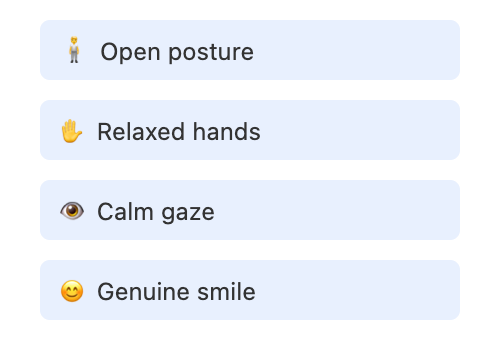Supporting your mentee isn’t just about what you say — it’s about how you say it, and what you communicate without words at all. Think of yourself as a conductor: your gestures, tone, and presence set the tempo for trust and openness. You can make your mentee feel truly seen and heard, or unintentionally put up barriers, all without saying a word. Remember that body language plays a crucial role in communication. See the image below for some tips on body language communication:

Here’s how to tune into the full spectrum of communication:
- Use open body language — like relaxed posture, eye contact, and genuine smiles — to show you’re present and engaged.
- Pay attention to your tone of voice. Warmth and encouragement can make praise feel authentic, while a flat or distracted tone can send mixed signals.
- In written messages, be mindful that your words don’t always carry your intent. Without facial expressions or tone, it’s easy for messages to be misunderstood.
Your mentee’s words are just one part of the story. Sometimes, what’s left unsaid is just as important as what’s spoken. If your mentee seems withdrawn, hesitant, or their written messages feel tense, don’t ignore those cues. Use your presence and body language to invite them to share more.
A helpful way to do this is the SOLER model:
- Sit squarely to show you’re fully engaged.
- Open posture signals you’re approachable and non-judgmental.
- Lean in slightly to show interest and attentiveness.
- Eye contact (without staring) helps your mentee feel seen and heard.
- Relax—your calm presence helps put your mentee at ease.
For example, if you notice your mentee is quieter than usual, try sitting with an open posture and saying:
“I noticed you seem a bit quieter today. If there’s anything on your mind, I’m here to listen.”
Or, if you get a message like:
“Sure, I’ll update it as you recommended.”
Instead of assuming agreement or enthusiasm, keep the door open:
“Thank you for being flexible! If you’d like to discuss any part of the recommendation or share your perspective, I’m always happy to chat.”
A quick rule of thumb:
- If you sense hesitation or discomfort, use both your words and your body language to invite your mentee to share more.
- If a written message feels off, clarify before jumping to conclusions.
By tuning into both nonverbal and written cues, you create a safe space where your mentee feels valued and supported.
Let’s see how this plays out in a real conversation:
- Natalie: I updated the project plan as you suggested.
- Milo: Thanks, Natalie! If you have any thoughts about the changes or want to discuss a different approach, I’m here to listen.
- Natalie: I was actually unsure if my original plan was missing something. I didn’t want to make things complicated by bringing it up.
- Milo: Not at all — I really value your input. If you’d like, we can look at both versions together and decide what works best.
- Natalie: That would be great, thanks. I appreciate you taking the time.
Notice how Milo doesn’t just respond to the words — he picks up on Natalie’s uncertainty and creates space for her to share her thoughts. This approach builds trust and encourages honest dialogue.
By tuning into both nonverbal and written cues, and responding with empathy and openness, you create a safe space where your mentee feels valued and supported. You’ll get to practice these skills in the next session, where you’ll interpret and respond to both spoken and unspoken needs.
